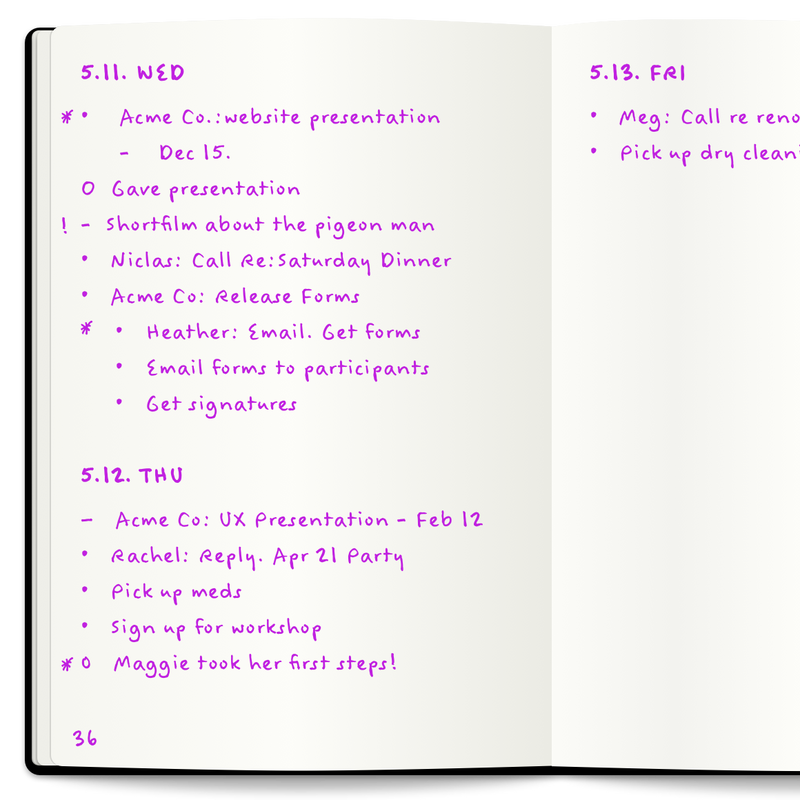The Bullet Journal Method, also known as “BuJo,” is a whole new way of managing your to-do list. It’s an analog technique made to organize tasks better in the digital age. Read on below to find out the 5 steps on how you can apply this philosophy cum productivity hack to your work tasks.
Never Ending Lists (Or so I Thought)
I am fond of making lists—grocery lists, to-do lists, any type of list. I love jotting things down to make sure that I won’t forget any important item. This applies to my work too. I make lists of things I need to accomplish, aiming to cross them all out at the end of the workday.
However, time and time again, once the clock strikes five, I’m still left with a long list of to-dos. That was until I discovered the 5 steps to The Bullet Journal Method.
The BuJo Method was created by Ryder Caroll, to find alternate ways to focus and be productive. Despite being diagnosed with learning disabilities early in his life, he developed The Bullet Journal Approach that goes beyond the simple organization.
5 Steps of The Bullet Journal Method
Below, I will be detailing the 5 steps on how to get yourself acquainted with the BuJo Approach. As mentioned above, this is an analog method, so grab your trusty pen and notebook. Dotted or grid pages are preferable, but any will do.
Before we begin, feel free to bookmark this page so that you can refer to this guide again if needed.
Step 1: Learn the Different Bullets per Type of Item
When making lists, we use bullets for every item. This is the same as The Bullet Journal Method. Although instead of using one type of bullet, we use three to mark different types of items:
- Dots (·) for Tasks
- Small Circles (o) for Events
- Dashes (-) for Notes
With these bullets, at one glance, you will be able to see the different types of items in your journal. Freely mix and match these bullets or make use of indents to group related items together.
Step 2: Write Your To-Dos in Short and Simple Words
Now that you know the different bullets to use, learn to jot down your to-dos in simple terms. Keep them short and easy to understand.

Step 3: Add Signifiers to Your Items
Signifiers are extra symbols that add more context to your journal. Use asterisks (*) to mark items of importance. Be mindful though—“if everything is important, then nothing is” (Patrick Lencioni).
Meanwhile, exclamation points (!) signify great ideas and inspiration.
Step 4: Put it All Together
Mark certain pages of your notebook for the following collections:
- Index – Put this on the first two pages of your journal. These will contain the page numbers of your logs for easy location.
- Future Log – After the Index, set four pages for your Future Log. This set of pages will contain your goals and to-dos for each month. Every start of the month, revisit this page to move your listed tasks to the Monthly Log.
- Monthly Log – Create this collection of two pages at the beginning of every month. The first page should contain a list of dates for the month, along with the highlight Event or Task for each day. Meanwhile, the second page should contain a list of your important tasks for the month.
- Daily Log – This log is designed for your day-to-day use. On each page, write the date, day, and start jotting your ideas. Remember to mark the page number below for indexing. It is better to create Daily Logs as the day comes to give yourself free space for writing the day before.
- Custom Collections – Since The BuJo Method has taken the world by storm, other people started coming up with their Bullet Journal designs. From habit and meal records to bills and savings trackers, set pages to make your journal your own.
5. Close and Migrate Tasks
After taking steps one to four learning about the different parts of The Bullet Journal, the fifth step tackles how to interact with it. At the beginning of the day, review your previous Daily Log.
- Mark completed tasks by crossing out (x) its bullet
- Strikeout irrelevant tasks
- Carryover unfinished tasks to today’s log with a greater than (>) sign
- Move tasks to your Future Log with a less than (<) sign
Be mindful when marking your tasks to make sure that you’re only migrating the truly important ones. If it’s such a hassle to rewrite, maybe it’s not as significant to your work as you initially thought.
Filtering Out the Unimportant
Apart from a system to organize tasks, The Bullet Journal Method is a philosophy. Writing down and migrating tasks lets you reflect on its urgency and importance. In doing so, you can filter out what is unimportant to your day-to-day work.
Ready to try it out? Couple The Bullet Journal Method with this time management hack that helps you finish more tasks in less time.

[…] that you need to accomplish. It is better to break them down into a short and simple list, just like in a bullet journal. Take note of the deadlines for each of these tasks to guide you in […]